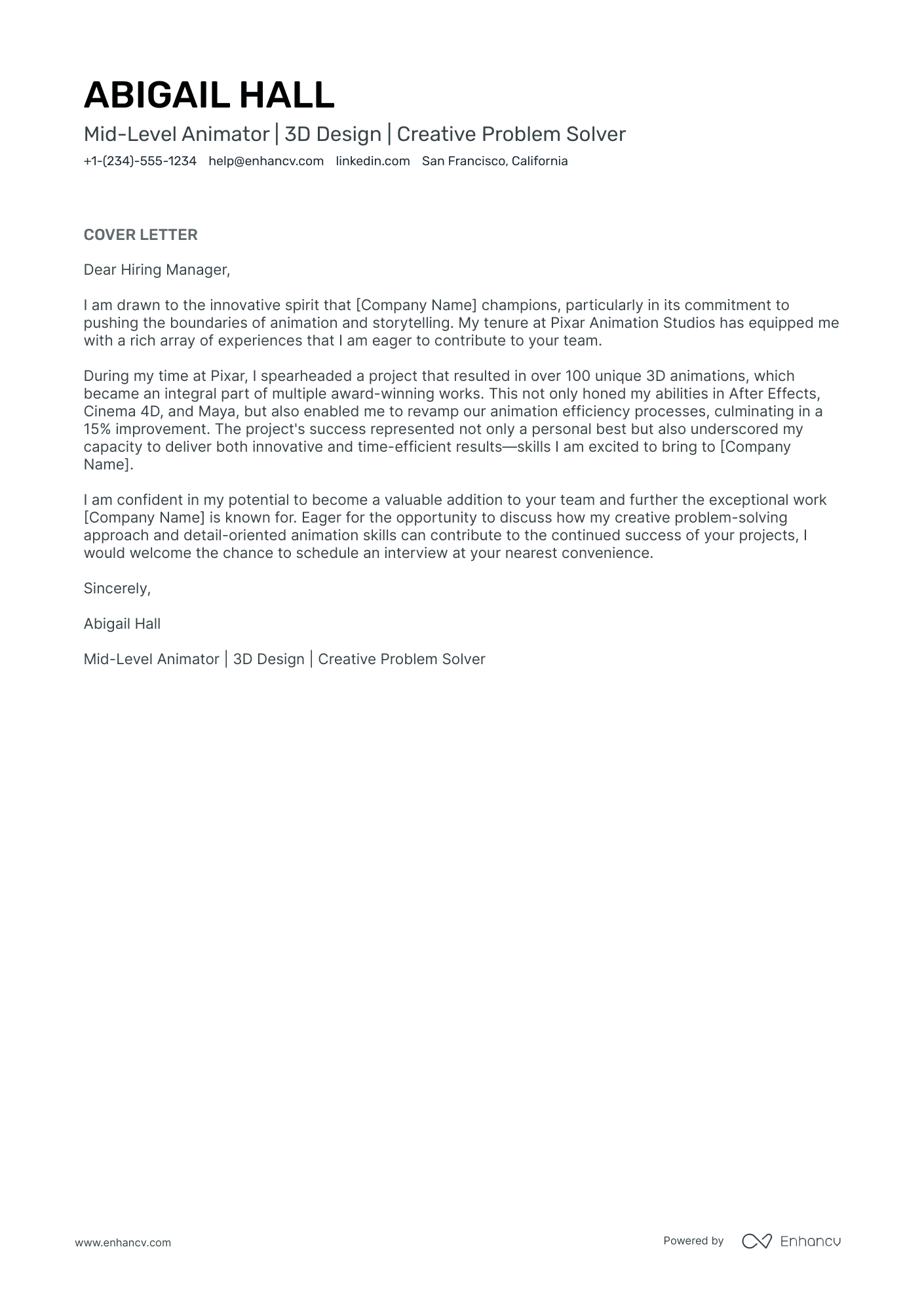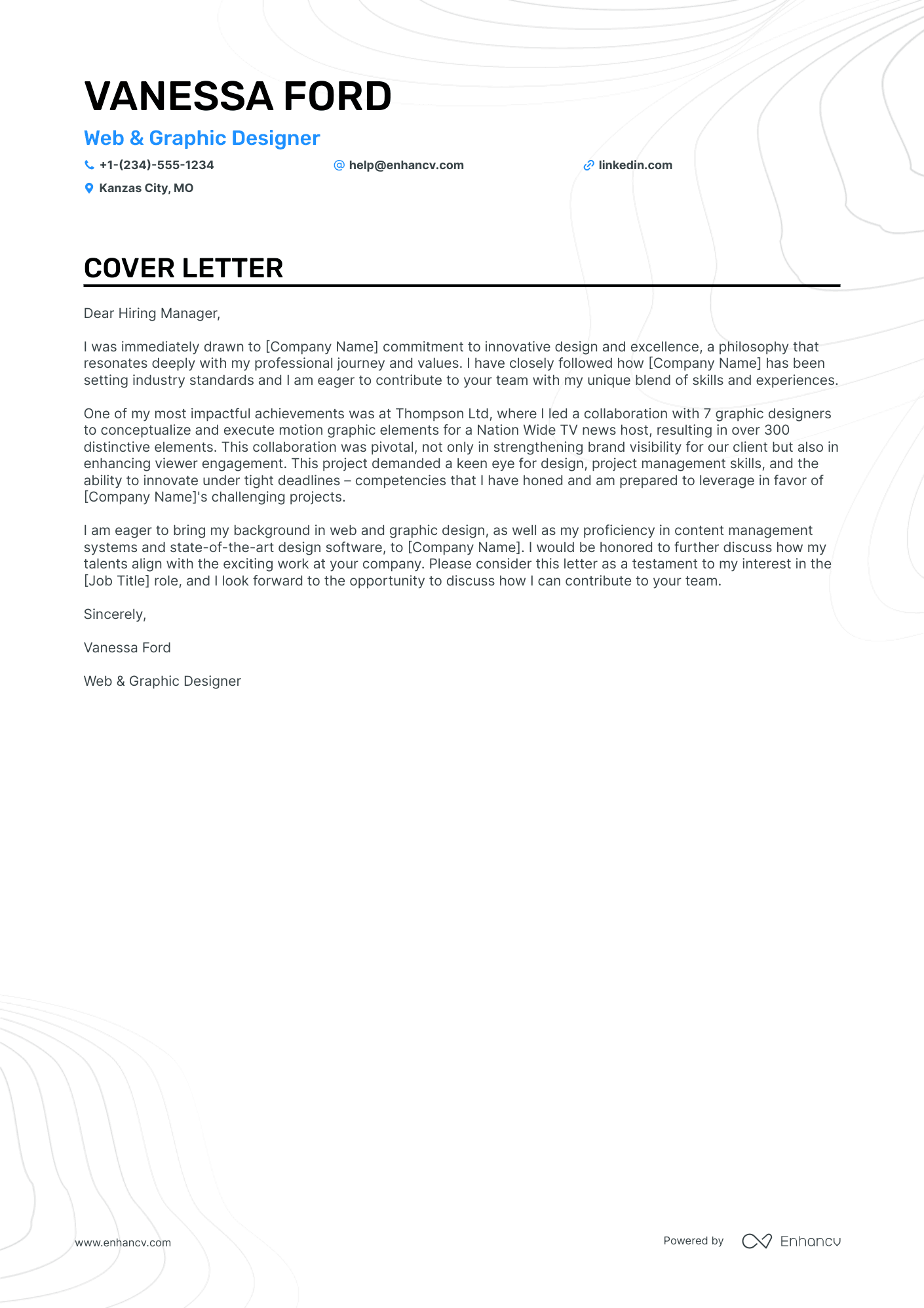Crafting a compelling animator cover letter can be daunting, especially when you're in the thick of job applications and realize you need more than just a polished resume. To stand out, weave a narrative around your crowning professional achievement rather than rehashing your CV. Stick to a page, dodging clichés while maintaining formality, to keep potential employers engaged. Let's explore how to pen that story-focused letter that aligns with your unique animation talents.
- Personalize the greeting to address the recruiter and your introduction that fits the role;
- Follow good examples for individual roles and industries from job-winning cover letters;
- Decide on your most noteworthy achievement to stand out;
- Format, download, and submit your animator cover letter, following the best HR practices.
Use the power of Enhancv's AI: drag and drop your animator resume, which will swiftly be converted into your job-winning cover letter.
If the animator isn't exactly the one you're looking for we have a plethora of cover letter examples for jobs like this one:
Drop your resume here or choose a file.
PDF & DOCX only. Max 2MB file size.
Animator cover letter example
VANESSA FORD
San Francisco, CA
+1-(234)-555-1234
help@enhancv.com
- Opening with a strong statement of past experience and success sets the tone for the cover letter and immediately grabs the hiring manager’s attention, showcasing the candidate’s passion and relevant achievements.
- Detailing specific job roles and the positive outcomes achieved, such as leading a team of animators as a Layout Director and executing a game-based study program, adds credibility and provides concrete examples of the candidate’s effectiveness and leadership in past roles.
- Mentioning the target age group of the children for whom the candidate has produced content demonstrates an understanding of the audience and an ability to tailor content to that demographic, which is crucial in educational animation.
- Ending with a call to action, suggesting an interview to further discuss the candidate’s fit for the position, demonstrates confidence and initiative while inviting the hiring manager to take the next step.
Structuring and formatting your animator cover letter
Here's what the structure of your animator cover letter should include:
- Header (with your name, the position you're applying for, and the date);
- Salutation (or greeting);
- Introductory paragraph (or your opening statement);
- Body paragraph (or further proof of your experience);
- Closing paragraph (with a call to action);
- Signature (that is optional).
Use the same font for your animator resume and cover letter - modern fonts like Lato and Rubik would help you stand out.
Your animator cover letter should be single-spaced and have a one-inch margins - this format is automatically set up in our cover letter templates and our cover letter builder.
When submitting your cover letter, always ensure it's in PDF, as this format keeps the information intact (and the quality of your document stays the same).
On one final note - the Applicant Tracker System (ATS or the software that is sometimes used to initially assess your application) won't read your animator cover letter.
Why spend hours writing a cover letter? Our free cover letter generator can do it for you in seconds.
The top sections on a animator cover letter
- Header with Contact Information: This should include your name, address, phone number, email, and the date, ensuring that the recruiter knows who you are and how to contact you, and giving a professional first impression.
- Opening Greeting: Address the hiring manager or recruitment team by name if possible to personalize the cover letter and show that you have done your due diligence in researching the company.
- Introduction and Intent: This section should briefly mention your interest in the animation position and how you discovered the job opening, making it clear that your cover letter is tailored to this specific role.
- Professional Experience and Animation Projects: Outline your relevant work experience, highlight specific animation projects you have worked on, and discuss your proficiency with animation tools and techniques, which demonstrate your practical skills and experience.
- Closing and Call to Action: Conclude by reiterating your enthusiasm for the opportunity, inviting the recruiter to review your enclosed portfolio or animation demo reel, and suggesting a follow-up meeting or interview to discuss how your skills align with the company's needs.
Key qualities recruiters search for in a candidate’s cover letter
- Strong portfolio showcasing diverse animation skills (2D/3D, motion graphics, character animation)
- Proficiency in industry-standard software (e.g., Adobe After Effects, Maya, Cinema 4D)
- Creative storytelling and visual communication abilities to effectively convey concepts and narratives
- Keen eye for detail and ability to maintain consistency in character design and motion
- Experience with rigging and skinning characters for animation
- Ability to adhere to deadlines and collaborate effectively with directors, other animators, and cross-functional teams
Greeting recruiters with your animator cover letter salutation
What better way to start your conversation with the hiring manager, than by greeting them?
Take the time to find out who the professional, recruiting for the role, is.
Search on LinkedIn, the company website. And for those still keen on making a fantastic first impression, you could even contact the organization, asking for the recruiter's name and more details about the job.
Address recruiters in the animator greeting by either their first name or last name. (e.g. "Dear Anthony" or "Dear Ms. Smarts").
If you're unable to discover the recruiter's name - don't go for the impersonal "To whom it may concern", but instead use "Dear HR team".
List of salutations you can use
- Dear [Hiring Manager's Name],
- Dear [Mr./Ms./Dr.] [Last Name],
- Dear [Hiring Team],
- Dear [Job Title] Search Committee,
- Dear [Company Name] Team,
- Dear [Department Name] Team,
The animator cover letter intro: aligning your interest with the company culture
You only have one chance at making a memorable first impression on recruiters with your animator cover letter.
Structure your introduction to be precise and to include no more than two sentences.
Here are some ideas on how to write a job-winning animator cover letter introduction:
- get creative - show off your personality from the get-go (if this aligns with the company culture);
- focus on your motivation - be specific when you say what gets you excited about this opportunity.
That one achievement in your animator cover letter body
The lengthiest part of your animator cover letter is the body.
Within the next three to six middle paragraphs, present yourself as the best candidate for the role.
How can you do that without retelling your whole professional resume?
Select one key achievement that covers job-crucial skills and technologies (and is memorable).
Within the body of your animator cover letter, aim to tell the story of how you achieved your success. Also, write about how this would help out your potential team.
Final words: writing your animator cover letter closing paragraph
The final paragraph of your animator cover letter allows you that one final chance to make a great first impression.
Instead of going straight to the "sincerely yours" ending, you can back up your skills with a promise of:
- how you see yourself growing into the role;
- the unique skills you'd bring to the organization.
Whatever you choose, always be specific (and remember to uphold your promise, once you land the role).
If this option doesn't seem that appealing to you, close off your animator cover letter with a follow-up request.
You could even provide your availability for interviews so that the recruiters would be able to easily arrange your first meeting.
Is it beneficial to mention that you have no experience in your animator cover letter?
Lacking professional experience isn't the end of the world for your animator cover letter.
Just be honest that you may not have had roles in the industry, but bring about so much more.
Like, your transferable skills, attained thanks to your whole work and life experience (e.g. the skills your summer spent working abroad taught you).
Or, focus on what makes you, you, and that one past success that can help you stand out and impress recruiters (think of awards you've attained and how they've helped you become a better professional).
Alternatively, write about your passion and drive to land the job and the unique skill set you would bring to enhance the workplace culture.
Key takeaways
Creating your animator cover letter should be a personalized experience for the role and the recruiter, where you:
- Format your cover letter using the same ATS-friendly font (e.g. Railway) as you did for your resume;
- Greet recruiters, using their name, and follow up with two sentences to introduce yourself, your interest in the role, and to stand out;
- Map out one key success from your career (or life) that has taught you job-crucial skills;
- Substitute your lack of experience with an achievement from your internships, degrees, or volunteering gigs;
- End with a promise for your potential or your availability for an interview.
Animator cover letter examples
By Experience
< - Main Article
By Role















